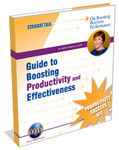 |
|
November 2021
Volume 17, Issue 11
These are free monthly tips on boosting
business and professional results.
Start your subscription!
To change subscription options, please
see the bottom of the page.
 Like us on Facebook! Like us on Facebook!
|
|
Greetings!
Below find this month’s newsletter, hot off the press!
Please add “Adele@LearnShareProsper.com” to your whitelist or address book in your e-mail program,
so that you have no trouble receiving future issues.
You subscribed to this newsletter at LearnShareProsper.com. You’re very welcome to forward it to your
colleagues; please just keep the entire message intact.
If you wish to discontinue your subscription, please
use the links at the bottom.
|
|
 |
|
A Prescription for Boosting Value — Testing Your Products!

Today’s newsletter is a new installment about the quality of your products and services, and a recognition that as you increase quality, you also increase the value your customers perceive in what you’re advertising. Perceived value ranks highly among the factors that people use to make buying decisions.
Therefore, the more you can enhance the perceived and actual value of your offerings, the more proudly and confidently you can market them to your audiences. Your brand promise can proclaim the extra distance you traveled to ensure complete customer satisfaction with your wares.
More than simply offering a refund policy for dissatisfied buyers, you’re staking out the other end of the spectrum — which is the value of building quality into what you offer, from the ground up. Doing this effectively should galvanize your customers’ loyalty and enable you to quickly bypass your competition.
So is there a “secret sauce” for this process? A key ingredient is beta testing. It’s an essential validation activity that many people have heard of, but don’t know how to perform. Even though it’s somewhat time consuming, if done systematically, it can make a world of difference with how well your product, service, system, or Web site performs right out of the box — and how thrilled your users will be with what you’re giving them.
With these ideas in mind, I hope you enjoy this month’s features, and please leave your comments on my Facebook page!
Here’s to your business prosperity,

Adele Sommers, Ph.D., business improvement specialist, author, educator, and award-winning instructional designer
P.S. If you missed any previous issue, please visit
the newsletter archive!
|
|

|
|
Quality in Perception vs. Quality in Fact

What’s the value of perception? Isn’t it interesting how our perceptions rule our beliefs and actions? So much of the brain research today seems to support the idea that our perceptions define our reality.
For that reason, we need to focus on the role of perception in the minds of consumers. Is the glass half empty or half full? The definition resides in our customers’ eyes!
People Perceive Quality in Many Ways
Regardless of how good we believe our offerings or project solutions are, our clients, customers, and users will be responding to “quality in perception” even more than “quality in fact.”
- Quality in fact refers to the features that we believe we’re paying for, such as how much something weighs, how fast it runs, how smoothly it operates, and various other characteristics.
- Quality in perception refers to things like courtesies, special considerations, a caring and personalized attitude, and a host of other subtleties that can lead us to believe we’re receiving something above and beyond what we’re paying for. Thus, effective quality in perception can help compensate for any gaps in quality in fact that could otherwise irritate or inconvenience consumers.
Read on to learn more ways to deliver outstanding quality in fact! |
|
 |
10 Strategies for Successful Beta Testing
by Adele Sommers
Successful beta testing begins in the earliest stages of project planning. Why is that? Because beta testing is meant to involve a methodical prove-in of a carefully planned outcome. It’s not meant to be a hit-or-miss, cross-your-fingers-and-hope-everything’s-OK bandage that you can apply at the very last minute. But first of all, why is it so important?
We’ve all seen examples of products — even some from well-known, respectable companies — that arrive on our desktops barely breathing. They seem to be so full of bugs that they cause us more grief than they help us actually do our work. Or we visit a Web site that looks great, but we can’t even navigate from the shopping cart to the order page. Or we buy a new device, yet despite using the instruction booklet, we can’t carry out the most basic functions the way we should be able to.
That’s why beta testing is so vital! It helps you figure out (and fix!) what may go wrong before your users find it themselves. But without a method to follow, you are only randomly banging on the system to see if by chance you can find a way to break it.
What should you be aiming to do? Using the checklist below, you’ll want to determine whether or not your product, service, system, or Web site will:
- Function without any bugs. The test procedure should verify that the features in the system are the same ones spelled out in the specification. It also should call for testing extreme scenarios as well as typical ones, and test the features in combination with one another in many different sequences. Your system, product, or site should either prevent, or smoothly respond to, any awkward situations that your users might fall into.
- Guide people to achieve their primary aims. Beta testing can examine the “big picture” aspects as well as the detailed minutiae. Can users successfully complete their high-level goals using the onscreen guidance and user guides?
- Handle extreme circumstances gracefully. Your product or system should deliver helpful, intelligent responses in any extreme conditions, such as when people might be stranded, working alone, or battling the elements. At the very least, the system should cause no confusion and inform users of their options.
Beta Testing Checklist
Below are 10 strategies for planning your next beta testing effort, carrying out the process successfully, and keeping your testers happy.
1. |
Design test scenarios. What’s a “test scenario”? Each test scenario should be mirror image of a “use scenario” that’s been guiding a team to design and develop the system. A use scenario describes a typical interaction that a user has with the system. For instance, for an automated teller machine (ATM), one scenario could involve a customer inserting a card in order to withdraw some cash. In another scenario, a customer makes a deposit. In another, he or she verifies the balance.
Scenarios must represent any plausible ways in which users could interact with the system, including unusual and unintended actions. Both use scenarios and test scenarios should account for possible error conditions like jammed cards, cancelled transactions, or overdrawn accounts. |
2. |
Write a test procedure. A test procedure specifies how testers will exercise the test scenarios, including the order to follow, as well as ways to run tests in a random sequence. It should also indicate what kinds of results to expect in each case.
You’ll want the procedure to test all new system features or changes, and run through certain features in various combinations. For an ATM, your procedure might specify 1) withdrawing cash, then 2) verifying the balance, and then 3) making a deposit. Be sure to vary the order, and test multiple error conditions. |
3. |
Determine the data you’ll need. If your system stores values in a database, you will need to pre-load some typical data to test the scenarios. In the ATM example, values would include account balances — for testing withdrawal limits and giving balance information. Create the sample data sets and pre-load the systems to be tested. Don’t forget to include extremely high and low values! |
4. |
Plan specific roles for testers. Schedule each tester to focus on certain test scenarios and related data sets. If there are enough testers, assign more than one to cover each test scenario, since each person will approach it differently. |
5. |
Create a bug reporting system. It could use paper forms, a database, an email method, or a combination. Have testers submit bug reports as they find errors in each round of testing. |
6. |
Establish a test schedule. The schedule should allow for several iterations of beta testing. Be sure to clear the schedules of testers for each round in which they will be participating. |
7. |
Get all materials ready for testing. The following items should be provided for the beta test kickoff meeting: A new or updated version of the system or product, descriptions of any bugs fixed, new or updated documentation, test scenarios, test procedures, and any other relevant info. |
8. |
Set a start date and schedule progress milestones. After the kickoff meeting, if testers find numerous bugs — or especially critical ones — before reaching a given milestone, stop testing, fix the bugs and/or documentation, and return to Step 1. Ask before restarting: Are new test scenarios or data sets needed? If so, get those organized before proceeding. |
9. |
Perform a new round of testing for each new test baseline. This means starting the complete test from scratch after each round of fixes. You can’t sidestep this requirement, because each time something is fixed, it can “break” something else. Stop the cycles of testing only when no new bugs are evident. |
10. |
Plan a reward for a job well done! Testing is tedious — so testers need a special incentive to keep them focused on the goal. Although they’re helping to produce a high-quality system, a post-testing party won’t hurt morale! |
In summary, thorough beta testing is essential for producing quality systems and products. If you go through these testing steps systematically each time, you should reap the reward of a well-earned reputation for high-quality user experiences!
Copyright 2021 Adele Sommers
|
|
 |
|
The “Guide to Boosting Productivity and Effectiveness”

Are you looking for a cookbook of great ideas for boosting your staff’s capabilities, eliminating hassles, streamlining procedures, and developing cutting-edge processes?
My Productivity
Success Kit offers a compendium of “how-to” techniques for increasing your organizational effectiveness.
This comprehensive special report includes 36 pages of tips, best practices, checklists, and worksheets that will help your business gain a potent competitive advantage! |
|
 |
|
Adele Sommers, Ph.D. is the author of “Straight
Talk on Boosting Business Performance” — an award-winning
Special Report and Workbook program.
If you liked today’s issue, you’ll love this down-to-earth
overview of how 12 potent business-boosting strategies
can reenergize the morale and productivity of your enterprise,
tame unruly projects, and attract loyal, satisfied customers.
It’s accompanied by a step-by-step workbook designed
to help you easily create your own success action plan.
Browse the table of contents and reader reviews on the
description page.
Adele also offers no-cost articles and resources to
help small businesses and large organizations accelerate
productivity and increase profitability. Learn more
at LearnShareProsper.com.
LearnShareProsper.com/Business Performance_Inc.,
705 North State Street #187, Ukiah, California,
USA.
For more information, e-mail Info@LearnShareProsper.com. |
|
|
|
| |
|
©2021
Business Performance_Inc., Adele Sommers, All rights
reserved. www.LearnShareProsper.com
Your feedback is always appreciated!
Write to us at info@LearnShareProsper.com.
We respect your privacy and do not give out or sell
subscriber names or e-mail addresses.
Please use the links below to take
yourself off our list or change your e-mail address.
|
|
|


